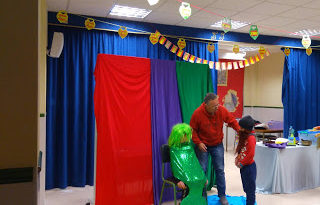TRADITIONAL STORIES WITH FUNNY TWISTS FOR THE ENGLISH CLASS.
First and foremost, at the heart of this paper is the idea that a modern and communicative perspective of foreign language teaching (FLT) entails the creation of attractive contexts where children naturally show willingness to participate. In this sense, the role of FL teachers to design an “appealing wrapping” which gives sense to the formative units seems to be out of the question. Therefore, the world of stories ought to be an invaluable framework for children to put into motion their communicative abilities.
The concept of fixed stories refers to using traditional ones or fairy tales, taking advantage of their universality and plots to come up with new versions in connection with the types of values we want to transmit. Moreover, there is a vast array of communicative tasks revolving around stories and drama.
Drama activities create a vast array of opportunities for classroom interactions in the FL, as they bring about a broad range from exercise-based games, short rehearsed scenes from familiar stories, basic role plays, and simulations. According to O’Neill and Kao (1998), the usefulness of every kind of drama in second language (L2) lies in the fact that it provides contexts for multiple language encounters and encourages authentic dialogue between teachers and students.
On the other hand, Maley and Duff (2005) suggest a series of benefits in using drama for FL teaching, such as the integration of skills, use of verbal and non-verbal language, the direct actions upon both cognitive and affective domains, the multi-sensory inputs children are exposed to, positive effects on classroom dynamics and learning atmosphere. To cut a long story short, out of the plenty of reasons to use drama tasks to teach English, perhaps one of the most important ones if the direct effect it exerts on children as for motivation.
Through groupwork, creative and cooperative learning activities can be organized to accomplish a number of types of learning tasks (i.e. writing blank speech bubbles in a comic story); or to create a number of different kinds of student groupings according to the learners´ characteristics (i.e. homogeneously or heterogeneously grouping students by level of content knowledge to cater for mixed-ability, or by level of interest). Co-operative learning groups can even vary over time; for example, groups could be formed for only one task, to meet every day until a specific activity is completed, and to meet regularly throughout the entire school year depending on the students’ characteristics and the pedagogical aims to be achieved.
The drama proposal in the shape of a project guides children from basic drama techniques, where they gain confidence and practice with the language, to a final product, consisting on the performance of the story each group has adapted for children in lower levels. This sense of audience can be enhanced through digital media (i.e. FL blog, school Facebook site, and the like). So as to organise the final product, children in heterogeneous groups are given a well-known traditional story (i.e. Goldilocks and the three bears) and transform the plot with slight changes that add a funny twist to the story.
Children can be informed about the need to teach “new generations” an updated perspective of traditional fairy tales, since the roles that women are given in them differ to a great extent from real equity. The springboard to illustrate this idea is the “Princess and the Pea”, a fairy tale where a princess has to go through a ridiculous test to show she was telling the truth. From the very beginning, these roles are identified; however, it is through the “fixed version” of the story that I intend to get them identify and analyse emotions, to develop empathy that can act as a “moral compass” to put in the shoes of others; and so understand why the Princess in the story didn´t like not to be trusted.
Devising this “performance product” carries along teacher´s support in different manners: set heterogeneous groups where each child knows the role in the different tasks, providing simple linguistic patterns to change a given script adapted to their linguistic level, monitoring the process to ensure success and provide enough time to rehearse. Indeed, giving them enough time to practice is at the heart of a successful production.
Obvious as it may seem, prior to the final product, children should “play with the language”. Therefore, in what follows we spell out some of the “rehearsing tasks” connected to each group´s story:
Hot seating. The teacher takes on the role of one character in the story and children make questions following models (i.e. why did you eat granny? No, in the end I didn´t, I´m a vegetarian wolf, so she cooked a delicious veggie soup for me).
In Synchronized Storytelling, children work in pairs to tell a story. One tells the story orally (with a reading script), while the other acts it out. They can then swap.
Through Good old friends, students practise simple simulations to develop their oral abilities and work on inhibition. In pairs, they represent short gags (i.e. in a party they meet an old friend they have not seen for so long).
In guise of a conclusion, it is especially interesting for FL teachers to consider storytelling and drama as valuable tools to contextualize learning and promote meaningful use of the four linguistic skills (listening, speaking, reading and writing). By doing so, we will be contributing to a wider goal, which is the attainment of basic communicative competence.
As we have seen, this integration of storytelling in the FL class requires careful selection, planning and gradation in the demands of tasks. As experienced primary teachers know, whatever the source, stories entail an intrinsic motivating power for children; accordingly, we should take advantage of these resources to create positive learning environments in which children feel the need to take active part.
As a final remark, it is very likely that the main reason to elaborate a project based on drama is that children are story lovers; and therefore, it is no wonder that motivation is one of the greatest benefits.
Bibliography:
-Maley, A. and Duff, A. (1998). “Drama Techniques: A resource book of communication activities for language teachers” (third edition).
-O`Neill, C and Kao, M.S. (1998), “Words into words: Learning a Second Language through process drama”. Ablex Publishing corporation.
Story by: HISHE Kids




